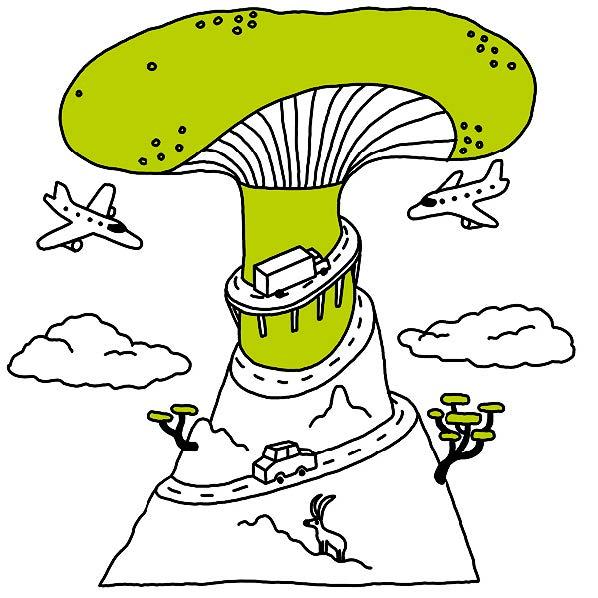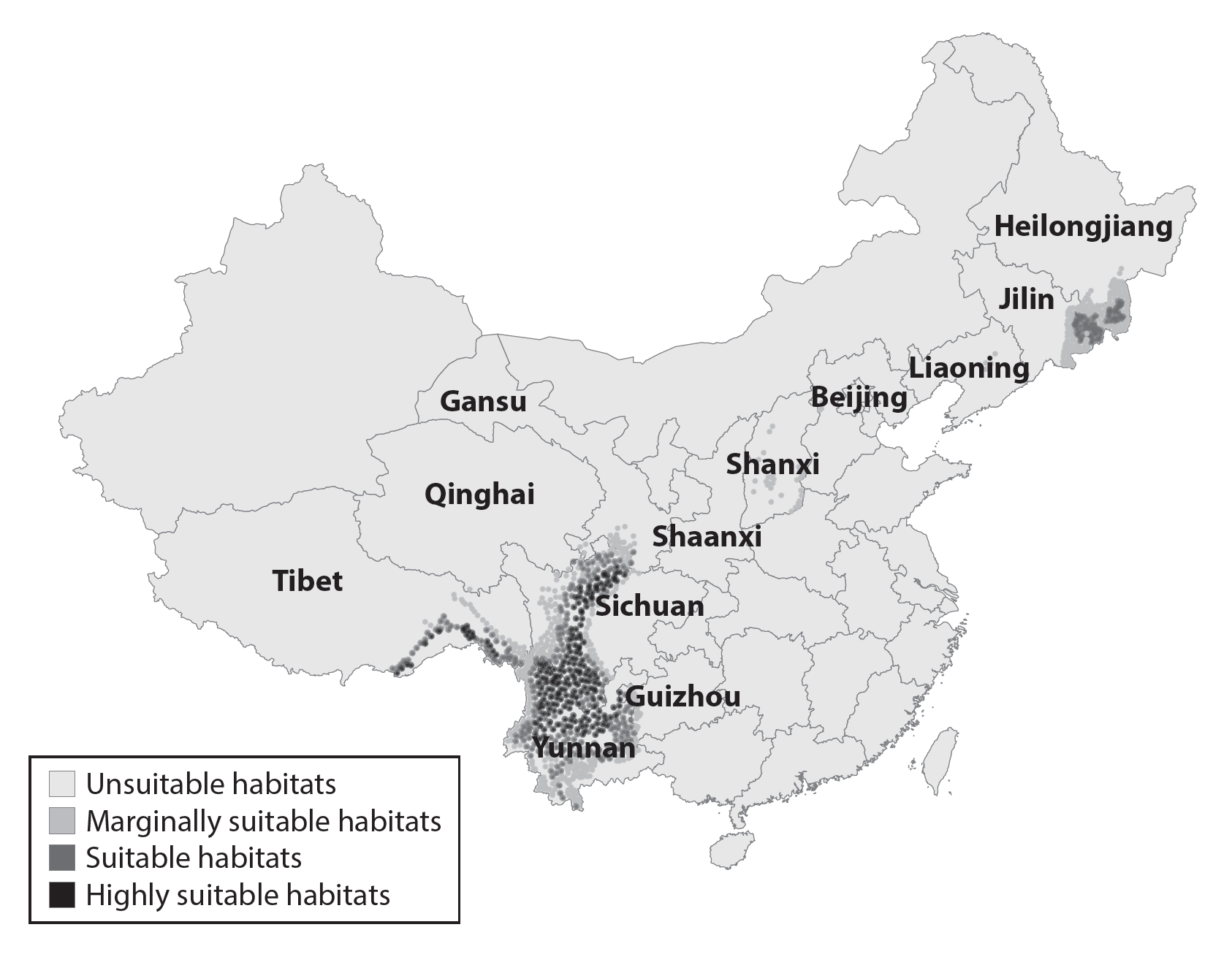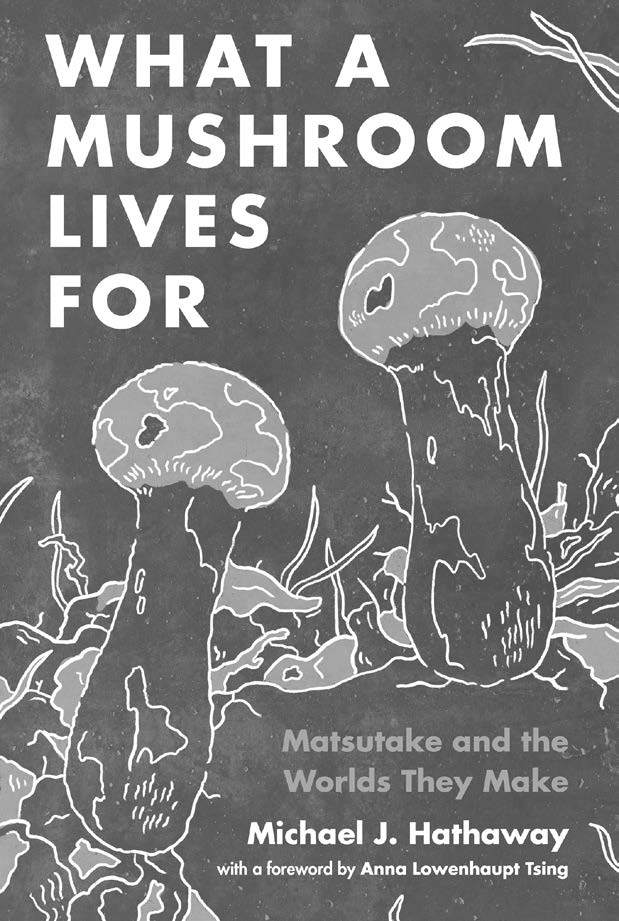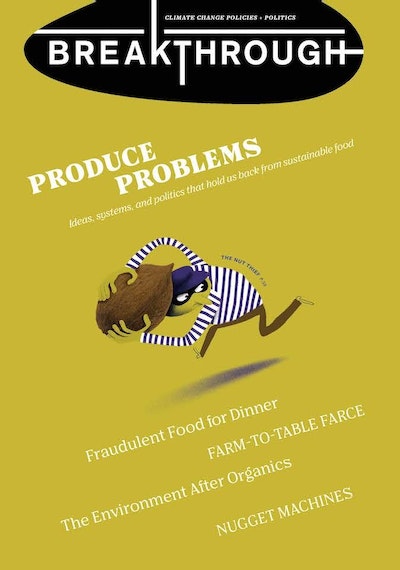Matsutake’s Journeys
What one mushroom tells us about war, trade, diet, and ecology
-
-
Share
-
Share via Twitter -
Share via Facebook -
Share via Email
-
All of the sudden, the mushrooms were everywhere: filling large bamboo baskets, and spilling out of woven plastic sacks. On their way to the airport, they were then stuffed into taxis, SUVs, and even passenger buses with the seats ripped out. Walking down the street in Kunming in Southwest China’s Yunnan Province in the late fall of 2019, you could catch a whiff of their strange scent, a mixture of cinnamon and sweetness and chili peppers.
Overnight, this place, tucked in the eastern Himalayas, had become the world’s key location for one of the planet’s most valuable wild mushrooms: the matsutake. These mushrooms are firm and white, and while the yak-herding Tibetans and goat-herding Yi people that had traditionally picked them eat all kinds of mushrooms, they never particularly loved these. Sometimes they’d get tossed in the soup pot, of course, but everything changed in the 1980s, when Japanese businessmen found out that they grew here.
In Japan, the matsutake is the quintessential flavor of the fall. And not in the way of chestnuts or Pumpkin Spice in the United States. Matsutake is so steeped in historical reverence that to take a bite of one is to take a bite of the past, when for centuries, only the nobility were allowed to eat them. Even hunting them has been long associated with a royal life of pleasure and indulgence, and a poetic tradition extolling their virtues that goes back over a millennia.
And now, these seemingly insignificant mushrooms, often hiding under the forest duff and easily unseen, power not just nostalgia but a vast trade network and economy spanning the globe. In some ways, matsutake have become another human-managed commodity, but in other ways they are still special.
For instance, unlike the circulation of other commodities such as oil, lumber, and steel—which make their way to nearly every country through a complex network—transnational flows of matsutake are more like a wheel with spokes: the mushrooms travel almost entirely to just one hub: Japan. Yet to power this commodity chain, a million people around the world coordinate their actions every day during matsutake season—finding mushrooms in the forest and then sending them to urban centers where, in turn, they will be shipped by air to Japan, then auctioned off and distributed to thousands of outlets, from small greengrocers to large grocery stores.
Following the trail of the mushroom, learning its stories, can help us understand much bigger things about the world, such as how every single organism on the planet comes into being—how, for as much as we know of humans’ devastating effects on the natural world, there is also a hidden dance, a back and forth between us and other life far beyond our capacity to manage.
Of course, the global pandemic reminded us of all these lively biological connections; how Horseshoe bats or civet cats may have fostered new viral forms that can travel to fellow mammals finding ripe conditions for expansion and circulation. But for now, we have a more enchanting story, one where the protagonist is not a virus, but a mushroom.

Where Do Matsutake Come From?
Our story starts in China’s Yunnan Province. Exactly how and when matsutake came there will almost certainly remain a mystery, and Yunnan is but one spot on the globe where matsutake and related species can be found. But it is certain that its journey began many years ago, long before most of the crop plants grown there arrived from the Middle East or the Americas, and even before modern humans had entered this landscape. Through their own efforts, by building relationships with trees, matsutake made a living in these places.
Today, looking at Yunnan from above, we see what looks like a contiguous island of matsutake habitat stretching down the eastern side of the Himalayas to the south toward Burma and Laos. But upon closer inspection, the habitat is actually a series of smaller, separate islands, each with its own microclimates and microhabitats.
At this southern latitude, the mushrooms prefer an elevation between 1,200 to 3,500 meters. Sometimes they live in a single ring around an isolated peak. Sometimes they cover the whole side of a slope; indeed a slope’s angle to the sun plays a major role in shaping local conditions. South-facing slopes are sunnier, warmer and drier, whereas north-facing slopes are shaded by the mountain itself, thus becoming colder and wetter.
Trees, in turn, shape the soil’s microclimate through their discarded leaves and needles, and this forest duff of rotting leaves and pine needles insulates the soil from the air: In terms of temperature, more duff delays the matsutake’s fruiting season.
Thus, the pickers learn about the mountains not as singular objects, but as complex topographies of many different places, all shaped by elevation, the sun, and even the world-making qualities of the trees themselves. For matsutake, after all, trees are critical life partners. Fungi can make relations with different plants to exchange minerals and water for photosynthetic sugars; indeed, they must. In other words, matsutake never grow alone; they grow in forests where they form intimate and obligatory relations with the trees around them.
From matsutake’s perspective, humans eventually did come to matter once they learned to use fire—to keep warm, cook food, and then, eventually (and most importantly for the sake of matsutake), transform landscapes.
In Yunnan, matsutake are able to fuse with either pine or oak, whereas in Japan, matsutake are mainly associated with the Japanese red pine. While some mushrooms like “chicken of the woods” that eat living wood can taste drastically different depending on what trees they are consuming, the matsutake’s complex tree partners have fewer implications for a human’s nose and mouth, and more for their eyes. In all cases, though, matsutake and their cousins are utterly essential to the forest’s ability to flourish, as below ground they are building vast networks of mycelia that the trees then rely on to find sufficient water and nutrients. In other words, mushrooms made the forests and forests made the mushrooms, even before people arrived and began their own symbiosis with the fungi.
Like the story of matsutake’s movement to this part of the world, the story of humans’ arrival is also still little known. Waves of human ancestors, starting with Homo erectus, probably began to show up more than a million years ago. Alongside other animals, humans might have eaten matsutake and spread their spores that way, but in Yunnan, humans contributed very little to this type of spread since the human population was so low for so long.

From matsutake’s perspective, humans eventually did come to matter once they learned to use fire—to keep warm, cook food, and then, eventually (and most importantly for the sake of matsutake), transform landscapes. Fire was a helpful but dangerous ally, aiding humans in driving wild animals. Early humans might have also noticed that after a fire, grasses and shrubs grew with additional force, providing more graze for the large mammals they hunted and creating sites of attraction. As human-made fires joined lightning-made fires, they likely facilitated the spread of pine forests, as some pine seeds sprout only after a fire and often grow quickly on burned-over land.
In places like Yunnan, more fires meant more pine trees, which in turn meant more potential for matsutake.
What Mushrooms Say About War
The last wave of early people, modern Homo sapiens, may have arrived in the area only 60,000 years ago or fewer, but the archaeological record is sparse until about 4,000 years ago. In some parts of China, the climate cooled over the past 5,000 years, from when elephants roamed the area of present-day Beijing. The same may have happened in Yunnan as well. If so, it would have further extended the range of pines and oaks down from the high edge of the Himalayas to the lower elevations and southward.
Then, beginning around two millennia ago, northern-based empires—led by Mongols, Manchu, and Han—carried out military campaigns to bring Yunnan under imperial rule. As the human population increased, people cut down forests for building materials, to fuel smelters, and to clear land for crops. During these times, after intensive deforestation, pines would grow back, and the matsutake populations would boost. Yak herding groups in northern Yunnan also burned pasturelands, which could kill tree saplings, and thus shrink the potential forests that matsutake need to survive. But overall, and compared to areas in eastern China where human populations were high and much of the land converted permanently to farm land, in Yunnan the human population remained relatively small, and so matsutakes could thrive.
By the 1930s, though, a series of events led Yunnan to rapidly build road and airport infrastructure that would later prove critical for the matsutake economy in the 1980s. First came the Japanese invasion of eastern China. In response to Japan shutting off supplies to the east coast, China started to build the Burma Road to bring supplies from the west. In 1938, nearly 200,000 Burmese and Chinese laborers accomplished their massive engineering feat: They connected Kunming in Yunnan to Lashio in Burma, a distance of 717 miles, using only hand tools such as shovels and hoes. This was the first transformation of Yunnan’s infrastructure away from trails for humans and mules and toward roads for cars and trucks.
In the public imagination, the loss of Japanese matsutake paralleled Japan’s loss of status in the world.
Yunnan became more connected to the rest of the world in other ways. After Japan launched bombing raids into Yunnan, China quickly built an airport in Kunming. Along with the airport and the roads came people. Specifically, academics. In the 1930s, when Japanese troops took over east coast cities, a large group of students and professors fled China’s elite universities near Beijing. Over several months, they walked to Kunming and created a new university, Lianda. After the war, some professors stayed and created Yunnan’s first nationally prestigious academic centers, such as the Kunming Institute of Botany (KIB), which became a key national center for fungi research. Through its research, the KIB played a large role in fostering the matsutake economy, studying its ecology, biology and potential uses as a medicine. Their scientists experimented with new ways to foster its growth in the wild, and how to potentially transplant it into new areas, also learning about the particulars of its growth, such as the mushrooms’ desired elevation, soil type and tree composition.
Meanwhile, in Japan, new markets for the mushroom were growing. Matsutake was historically a sumptuary good, and there were laws against it being eaten by commoners. Although poets had hailed its mouth-watering smell more than 1,200 years ago and it was regarded as “a taste of autumn from the old days,” few had actually tasted it.
That, too, changed as Kunming was changing. Hardwood forests were cut down to fuel the military machine. In their place sprouted pines that matsutake could grow with. For the first time, there were enough of the mushrooms around for everyone. They even became cheap.
Some people even saw this as a good omen to signal Japan’s rise as a global power. At this time, Japan’s wartime victory seemed likely; plans were underway to attack Pearl Harbor within a year.
The war and the mushroom bonanza soon faltered, however. The emperor surrendered in 1945, and by the 1970s, domestic sales had dropped from over 12,000 metric tons to under 200 metric tons, both because people were poorer but also the mushrooms themselves failed to materialize. In the public imagination, the loss of Japanese matsutake paralleled Japan’s loss of status in the world.
Matsutake and Japan's Decline
Matsutake’s precipitous decline in Japan was seen as a national tragedy, and many tried to explain why the mushrooms were disappearing. Biologists discovered that the pine forests were in decline, and it took scientists another decade to realize that acid rain—rain contaminated by pollutants coming mainly from Chinese coal-powered factories and energy plants—was damaging trees in Japan.
In other words, China’s coal smoke was unwittingly boosting China’s own role in the matsutake economy by generating pollution that reduced the abundance of matsutake in Japan. In response to the discovery of acid rain, Japan poured massive funds into retrofitting Chinese factories. At the time, these efforts were seen as a natural part of Japan’s role as China’s most important trading partner and a form of international development aid. Further, Japanese entrepreneurs teamed up with scientists to find new sources of matsutake around the world, which included traveling to Yunnan—and following some of the same roads built to defend Yunnan against their soldiers some thirty years earlier.
It still remains somewhat of a mystery why they thought to look there, but according to some stories circulating in Japan, it was hunger for matsutake that prompted the scientists to improve some of the world’s early Geographic Information Systems (GIS), which used computers to overlay maps of climate, soils, forest types and the like to predict places around the world where matsutake might be growing. Whether informed by GIS or not, in many cases the scientists’ guesses were correct, and entrepreneurs and others started building a global trade in matsutake.
This new trade significantly changed sales in Japan. In the early 1970s, almost every matsutake eaten in Japan was gathered domestically, but by 1980, Japan imported 362 metric tons of matsutake each year, making import levels roughly equivalent to domestic levels. Imports increased dramatically from that point, and within nine years, they had reached 2,210 metric tons.
It was not that already existing markets in other countries were redirected to Japan; rather, Japanese scientists and businessmen traveled abroad to search out new matsutake populations. Almost nowhere in the world, except in Korea, was there an existing economy in place. In North America, Canada began shipping matsutake in 1978. Some pickers reportedly earned $1,000 in a week, even with the relatively low value of about ten Canadian dollars per kilogram. In the same year, two Japanese researchers mapped matsutake’s distribution in the United States and Canada, revealing new places that pickers did not know about and encouraging the development of a North American market.
Alongside the mushroom mania, throughout the late 1980s and early 1990s, Japan experienced an economic boom, and matsutake prices shot up. In Canada, some pickers now reported making $1,000 a day. These kinds of profits were unheard of, given that other people working in the forest gathering salal stems for the florist trade, or even wild chanterelle mushrooms for the European market, never made money like that. (In 1992, on average, the highest-grade matsutake fetched nearly ten times the price of chanterelles.)
In China, such levels of wealth were never achieved. Yet in proportion to previous incomes in Yunnan—often less than $200 a year—it was still a kind of bonanza for pickers. As one Tibetan man put it, “It was like we found a new kind of gold, but we didn’t have to dig for it. It came back every year, even if we picked every one the previous year. It was not like anything we had before.”
Why didn’t pickers in China earn the kinds of fortunes possible in North America? It is likely that Japanese dealers knew that they could pay Chinese pickers much less for these mushrooms, thereby keeping more profit for themselves. It was also still relatively difficult to get Yunnan’s mushrooms from the slope to the market. Mushrooms often traveled without refrigerated trucks, on rutted dirt roads or bumpy cobblestone roads for many miles. Things opened up as plane fares dropped and boxes of fresh mushrooms were flown into Japan.
Yet at the peak of matsutake profits and conspicuous consumption of luxury goods, Japan’s boom economy deflated, ushering in a decade of stagflation and efforts to catch up ever since.
Since then, matsutake prices have oscillated frequently but have gone down substantially overall. Meanwhile, Beijing made most logging illegal starting in 1999. Logging revenues had funded 80% of local government budgets especially in the areas of highest matsutake growth and the overall economy shifted quickly away from cutting trees toward other activities. Matsutake hunting emerged as one of the easiest ways to make money with the least amount of investment in training or tools; it was an activity done largely according to one’s own schedule, and with no boss.

And so, by 2000, China was selling more than half of the world’s matsutake exports to Japan, and Southwest China made up around three-quarters of China’s exports. Although the matsutake did not always fetch high prices, many villagers embraced hunting and selling it in the season. (In 2017 the price briefly shot up to 3,000 yuan per kilo, spurring another case of “matsutake fever,” after few mushrooms sprouted that spring.)
Given the demand, it might make sense to try to cultivate the fungus. But at the other end of the food chain, Japanese consumers view matsutake as a wild good, and this means that they expect very low levels of contaminants like pesticide compared to what they allow for farm crops. This demand forces Chinese dealers to be extremely cautious, for there are many ways, besides intentionally spraying the forest or warehouse, that matsutake can be unintentionally exposed to pesticides. It can happen via drifts from nearby fields, or from carrying them in baskets that previously held sprayed vegetables, or by touching them with unwashed hands after working in the agricultural fields. Perhaps even more important, unlike European consumers, who expect to eat their porcini and morels in dried form, Japanese consumers for the high-end market demand that matsutake be fresh, not frozen or dried, both of which processes change the smell and the taste.
The desire for fresh, versus dried or frozen, mushrooms places significant demands on pickers and exporters. Dried mushrooms can be stored for years, making them a commodity that can be stockpiled while waiting for a better price. But fresh matsutake can’t sit long; a pile of valuable mushrooms will quickly turn to mush. Consumer demand for freshness might change; not all Japanese consumers are gourmands, and few want to spend exorbitant amounts of money on matsutake (one can easily find instant noodle packets with artificial matsutake flavor).
But given Japan’s centuries-long passion for matsutake, there will likely continue to be willing buyers, at a fluctuating price, for some time to come. Among scientists in Japan, even those who are working hard to try to cultivate it, there exists a fear that if they are successful, the end product will be different—not as good.
It’s All Connected!
There is no guarantee that matsutake will continue to flourish in Yunnan; perhaps, as was the case in Japan, they will start to vanish as people do more to conserve the forests. Like the logging ban, the conservation of forests might actually contribute to the demise of matsutake as the pines begin to age excessively. And on the consumer side, the market is centered so much on Japan that it could end entirely if Japanese palates no longer crave the taste of matsutake.
When I talked with villagers in the two main groups that hunt matsutake in Yunnan, the Yi and the Tibetans, I found that many of them did not take matsutake’s continued presence for granted. Instead, they saw them as a gift—one that might disappear. Since the 1980s, when matsutake economy first launched, each group has started to recalibrate their annual patterns of work in relationship to this mushroom, in turn reconfiguring their relations to other living beings that have their own demands, such as corn and goats, barley and yaks.
In that way, the matsutake and its worlds have much to reveal about nature and life. One thing that stands out is how interconnected all of these beings are, and how ancient geological history shapes modern trade and politics. Without the high elevations of the Himalayan Mountains, this subtropical area would have never allowed the right kinds of pine and oak for matsutake to grow. And yet, geology is not the complete answer, for it took the presence of matsutake and hundreds of other species to travel to Yunnan, and form intimate mycelial relations with these trees. Without fungi, these forests might not have appeared, or could have disappeared. Without the World War, humans might not have made their way to the forest at the right moment. Without China’s economic boom, Japan might not have looked to its neighbor to satisfy its mushroom hunger. And without the boom in the matsutake trade, Tibetans and Yi who dedicated their lives to the autumnal hunt might have transformed their work in other ways.
These stories, however, are always more than human—the decisions about how to live and who to make relations with is something that all living beings do, and in so doing shows the lively interconnections between all things.
Excerpt from What a Mushroom Lives For by Michael J. Hathaway.



